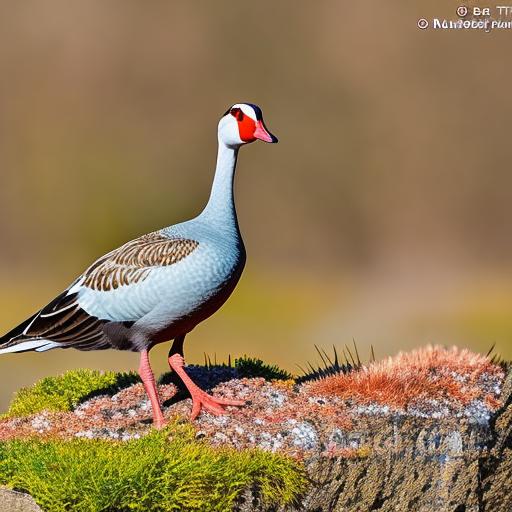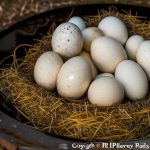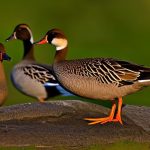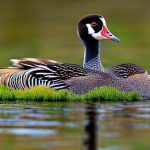Ornamental geese breeds are a popular choice among farmers and pet owners alike. These breeds are known for their unique and beautiful appearance, as well as their friendly and docile nature. Ornamental geese breeds are often kept for their aesthetic value, as they can add a touch of elegance and charm to any farm or backyard. In addition, these geese are also valued for their practical uses, such as weed control and egg production.
Key Takeaways
- Ornamental geese breeds are a group of domesticated geese that are primarily kept for their aesthetic value.
- The history of ornamental geese breeds can be traced back to ancient times, with some breeds originating in Asia and Europe.
- Ornamental geese breeds come in a variety of colors and patterns, with unique physical features such as crests and knobbed bills.
- Popular ornamental geese breeds include the Sebastopol, Toulouse, and Chinese breeds, each with their own distinct traits.
- Caring for ornamental geese requires proper housing, feeding, and health considerations, as well as tips for successful breeding.
History and origins of ornamental geese breeds
The domestication of geese can be traced back to ancient times. Geese were first domesticated in ancient Egypt around 4,000 years ago, where they were raised for their meat, eggs, and feathers. Over time, different breeds of geese were developed for specific purposes, such as meat production or egg laying.
Ornamental geese breeds came to be through selective breeding for their unique physical features and temperament. Breeders sought to create geese that were not only functional but also aesthetically pleasing. This led to the development of breeds with striking colors, patterns, and feather types.
Geese have played an important role in different cultures and traditions throughout history. In ancient Rome, geese were considered sacred animals and were often kept in temples. In Chinese culture, geese symbolize fidelity and are often depicted in art and literature. Geese have also been associated with migration and the changing of seasons in many cultures.
Characteristics and physical features of ornamental geese breeds
There are several different types of ornamental geese breeds, each with its own unique characteristics and physical features. Some popular ornamental geese breeds include the Sebastopol goose, the Pilgrim goose, and the Toulouse goose.
The Sebastopol goose is known for its curly feathers, which give it a distinctive appearance. These geese have a calm and friendly temperament, making them popular among pet owners. The Pilgrim goose is a small breed that is known for its ability to lay eggs without the need for mating. This makes them a popular choice for those who want geese for egg production but do not want to deal with the challenges of breeding.
The Toulouse goose is one of the largest domesticated goose breeds and is known for its meat production. These geese have a calm and docile nature, making them easy to handle. They also have a distinctive gray plumage, which adds to their appeal.
Popular ornamental geese breeds and their unique traits
There are many popular ornamental geese breeds, each with its own unique traits and characteristics. One such breed is the Sebastopol goose, which is known for its curly feathers. These geese have a calm and friendly temperament, making them popular among pet owners. They are also good foragers and can help control weeds in the garden.
Another popular ornamental geese breed is the Pilgrim goose, which is known for its ability to lay eggs without the need for mating. This makes them a popular choice for those who want geese for egg production but do not want to deal with the challenges of breeding. Pilgrim geese are also known for their calm and docile nature, making them easy to handle.
The Toulouse goose is one of the largest domesticated goose breeds and is known for its meat production. These geese have a calm and docile nature, making them easy to handle. They also have a distinctive gray plumage, which adds to their appeal.
Caring for ornamental geese breeds: housing, feeding and health considerations
Caring for ornamental geese breeds requires attention to their housing, feeding, and health needs. Geese need a secure and spacious enclosure that provides protection from predators and the elements. The enclosure should have access to fresh water for swimming and drinking, as well as plenty of grass or pasture for grazing.
Feeding ornamental geese breeds requires a balanced diet that includes a mix of grains, greens, and protein. Geese should have access to fresh water at all times, as they need it for digestion and to keep their feathers clean. It is also important to provide them with grit, which helps them digest their food.
Like any animal, ornamental geese breeds are susceptible to certain health issues. Common health issues in geese include respiratory infections, parasites, and foot problems. Regular veterinary check-ups and proper hygiene practices can help prevent these issues. It is also important to provide geese with a clean and dry living environment to prevent the spread of disease.
Breeding ornamental geese: tips and tricks for successful breeding

Breeding ornamental geese requires careful planning and attention to detail. Geese are monogamous animals and form strong pair bonds, so it is important to choose compatible breeding pairs. Breeding usually takes place in the spring, when the weather is warmer and there is plenty of food available.
To encourage successful breeding, it is important to provide geese with a suitable nesting area. This can be a simple nest box or a natural nesting site, such as a secluded spot in the grass or near water. The nest should be lined with straw or other soft materials to provide comfort and insulation.
Once the eggs are laid, it is important to provide the female with a quiet and secure environment to incubate them. The eggs will typically hatch after about 28-30 days. It is important to provide the goslings with warmth, protection, and proper nutrition during their first few weeks of life.
Ornamental geese in agriculture and farming: benefits and challenges
Ornamental geese can be a valuable addition to agriculture and farming operations. They can help control weeds and pests, as they are excellent foragers. Geese also produce high-quality meat and eggs, making them a sustainable source of food.
However, raising ornamental geese in a farming setting can also present challenges. Geese require a large amount of space to roam and graze, which may not be feasible for all farms. They can also be noisy and messy, which may not be suitable for all farming operations.
Despite these challenges, ornamental geese can contribute to sustainable farming practices. They can help reduce the need for chemical pesticides and fertilizers by controlling weeds and pests naturally. They also provide a source of income through the sale of meat, eggs, and feathers.
Ornamental geese in urban settings: keeping geese as pets
Ornamental geese can also be kept as pets in urban settings. They are relatively low-maintenance animals and can be a unique and interesting addition to a backyard or small farm. Geese are social animals and enjoy the company of humans, making them good companions.
Keeping geese as pets in an urban environment does present some challenges. Geese require a large amount of space to roam and graze, so it is important to provide them with access to a secure outdoor area. They can also be noisy, so it is important to consider the noise regulations in your area.
Despite these challenges, keeping ornamental geese as pets can be a rewarding experience. They are intelligent animals that can form strong bonds with their human caregivers. They also have unique personalities and behaviors that can provide entertainment and companionship.
Ornamental geese in cultural traditions: geese in art, literature and folklore
Geese have played an important role in different cultures and traditions throughout history. In ancient Rome, geese were considered sacred animals and were often kept in temples. They were believed to have the power to ward off evil spirits and bring good luck.
In Chinese culture, geese symbolize fidelity and are often depicted in art and literature. They are associated with loyalty and devotion, and are often used as symbols of love and friendship. Geese are also a common motif in traditional Chinese paintings, where they are often depicted in serene and peaceful landscapes.
Geese have also been depicted in art, literature, and folklore in other cultures around the world. In European folklore, geese are often associated with the changing of seasons and the migration of birds. They are also a common motif in fairy tales and children’s stories.
the beauty and diversity of ornamental geese breeds.
Ornamental geese breeds are a unique and beautiful addition to any farm or backyard. They come in a variety of colors, patterns, and feather types, making them a visually striking choice. In addition to their aesthetic value, ornamental geese breeds also have practical uses, such as weed control and egg production.
Caring for ornamental geese breeds requires attention to their housing, feeding, and health needs. Geese need a secure and spacious enclosure, as well as a balanced diet that includes grains, greens, and protein. Regular veterinary check-ups and proper hygiene practices can help prevent health issues.
Breeding ornamental geese requires careful planning and attention to detail. Geese form strong pair bonds and require a suitable nesting area for successful breeding. Once the eggs hatch, it is important to provide the goslings with warmth, protection, and proper nutrition.
Ornamental geese can be a valuable addition to agriculture and farming operations. They can help control weeds and pests naturally, reducing the need for chemical pesticides and fertilizers. Geese also provide a source of income through the sale of meat, eggs, and feathers.
Keeping ornamental geese as pets in urban settings can be a rewarding experience. Geese are social animals that enjoy the company of humans and can form strong bonds with their caregivers. However, it is important to consider the space and noise requirements of geese in an urban environment.
Geese have played an important role in different cultures and traditions throughout history. They are often associated with loyalty, love, and the changing of seasons. Geese have been depicted in art, literature, and folklore in various cultures around the world.
In conclusion, ornamental geese breeds are a beautiful and diverse group of animals that can bring joy and practical benefits to farmers and pet owners alike. Their unique physical features, friendly nature, and practical uses make them a popular choice among those looking for a unique addition to their farm or backyard. Whether kept for their aesthetic value or their practical uses, ornamental geese breeds are sure to add charm and elegance to any setting.
If you’re interested in ornamental geese breeds, you may also find this article on Poultry Wizard interesting: “Can Geese Eat Chicken Feed?” It discusses the compatibility of chicken feed with geese and provides insights into the nutritional needs of geese. Understanding what to feed your geese is crucial for their health and well-being. To learn more about this topic, click here. Additionally, if you’re considering turning a shed into a chicken coop, Poultry Wizard has a helpful guide on the topic. Check out their article titled “Turning a Shed into a Chicken Coop” by clicking here. Lastly, if you want to ensure your chicken coop is well-insulated, Poultry Wizard offers valuable tips in their article “How to Insulate a Chicken Coop.” Discover effective ways to keep your chickens warm during colder months by clicking here.
FAQs
What are ornamental geese breeds?
Ornamental geese breeds are domesticated geese that are primarily kept for their ornamental value rather than for meat or egg production. These breeds are often smaller in size and have unique and attractive physical characteristics.
What are some examples of ornamental geese breeds?
Some examples of ornamental geese breeds include the Sebastopol goose, the African goose, the Chinese goose, the Toulouse goose, and the Pilgrim goose.
What is the size range of ornamental geese breeds?
Ornamental geese breeds can range in size from small bantam breeds that weigh only a few pounds to larger breeds that can weigh up to 20 pounds.
What is the lifespan of ornamental geese breeds?
The lifespan of ornamental geese breeds can vary depending on the breed and the care they receive, but they typically live for 10-15 years.
What is the temperament of ornamental geese breeds?
The temperament of ornamental geese breeds can vary depending on the breed and the individual bird, but they are generally docile and friendly if they are raised and handled properly.
What is the purpose of keeping ornamental geese breeds?
The purpose of keeping ornamental geese breeds is primarily for their ornamental value, as they are often kept as pets or for exhibition. They can also be used for weed control and as watchdogs.
What is the care required for ornamental geese breeds?
The care required for ornamental geese breeds includes providing them with a safe and secure enclosure, access to clean water and food, and regular grooming. They also require regular veterinary care and vaccinations.
Meet Walter, the feathered-friend fanatic of Florida! Nestled in the sunshine state, Walter struts through life with his feathered companions, clucking his way to happiness. With a coop that’s fancier than a five-star hotel, he’s the Don Juan of the chicken world. When he’s not teaching his hens to do the cha-cha, you’ll find him in a heated debate with his prized rooster, Sir Clucks-a-Lot. Walter’s poultry passion is no yolk; he’s the sunny-side-up guy you never knew you needed in your flock of friends!







